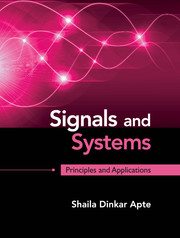Book contents
- Frontmatter
- Dedication
- Contents
- Preface
- 1 Introduction to Signals
- 2 Signals and Operations on Signals
- 3 CT and DT Systems
- 4 Time Domain Response of CT and DT LTI Systems
- 5 Fourier Series Representation of Periodic Signals
- 6 Fourier Transform Representation of Aperiodic Signals
- 7 Laplace Transform
- 8 Z Transform
- 9 Random Signals and Processes
- Index
9 - Random Signals and Processes
Published online by Cambridge University Press: 05 May 2016
- Frontmatter
- Dedication
- Contents
- Preface
- 1 Introduction to Signals
- 2 Signals and Operations on Signals
- 3 CT and DT Systems
- 4 Time Domain Response of CT and DT LTI Systems
- 5 Fourier Series Representation of Periodic Signals
- 6 Fourier Transform Representation of Aperiodic Signals
- 7 Laplace Transform
- 8 Z Transform
- 9 Random Signals and Processes
- Index
Summary
The theory of signals and systems is applied for the processing of signals like speech signal, RADAR signal, SONAR signal, earth quake signal, ECG and EEG signals. All these signals are naturally occurring signals and hence have some random component. The primary goal of this chapter is to introduce the principles of random signals and processes for in-depth understanding of the processing methods. We will introduce the concept of probability and will discuss different standard distribution functions used for the analysis of random signals. Different operations on the random variables namely expectation, variance and moments will be introduced. We will then discuss central limit theorem. The classification of random processes namely wide sense stationary, ergodic and strict sense stationary processes will be defined.
Probability
Consider the experiment of throwing a dice. The result of the throw is random in nature in the sense that we do not know the result i.e., the outcome of the experiment until the outcome is actually available. The randomness in the outcome is lost once the outcome is evident. The result of the experiment is either a 1dot, 2dots, 3dots and so on. The outcome is a discrete random variable. Here, there are only 6 possibilities and so one can easily find the probability of getting 1 dot is 1/6 evaluated as one of total possible outcomes. If the experiment is performed a large number of times, the ratio of frequency of occurrence of a 1dot and the total number of times the experiment is performed approaches 1/6 (Refer to Eq. (9.1)).
We will first define the term event. When any experiment is performed to generate some output, it is called as an event. The output obtained is called as the outcome of the experiment. The possible set of outcomes of the experiment is called as a space or as event space or sample space. Many times, there is the uncertainty or randomness involved in the outcome of the experiment. The term probability is closely related to uncertainty. In case of the experiment of throwing of a die, the uncertainty is involved in the outcome. When a die is thrown, we do not know what will be the outcome. Using the notion we may define a relative frequency of occurrence of some event. Consider the example of a fair coin. Let it be tossed n times. Let nH times Head appear.
- Type
- Chapter
- Information
- Signals and SystemsPrinciples and Applications, pp. 693 - 766Publisher: Cambridge University PressPrint publication year: 2016



